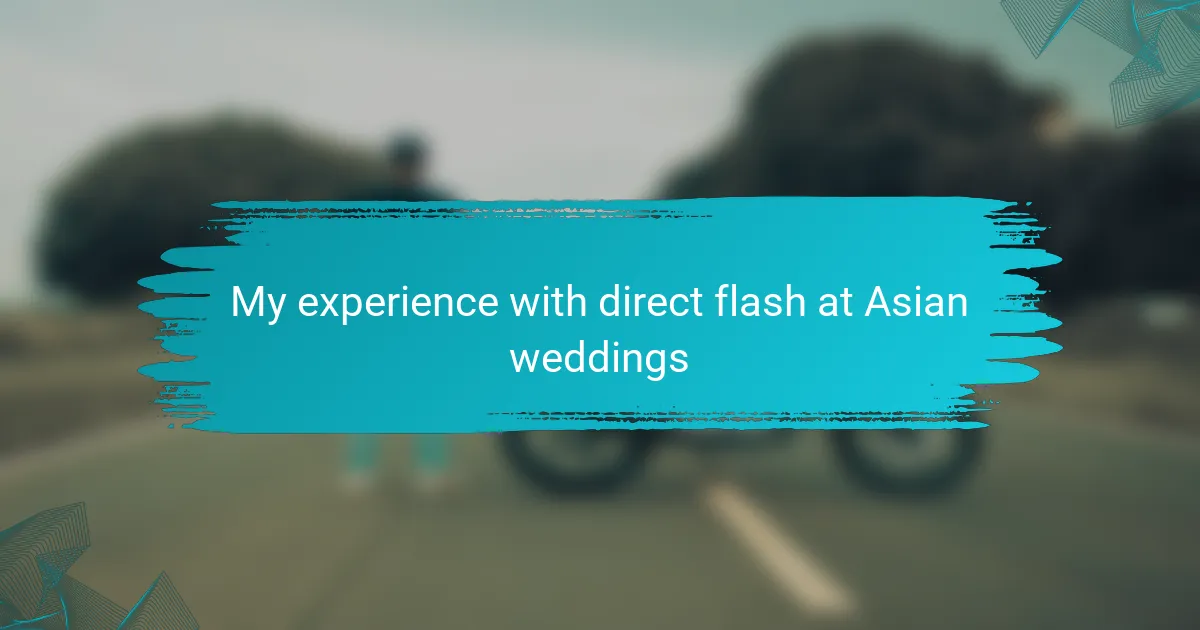Key takeaways
- Direct flash enhances vibrant colors and intricate details in wedding photography, especially in dynamic settings like Asian weddings.
- Proper lighting creates a desired atmosphere and can transform simple scenes into emotional narratives.
- Using techniques such as bouncing flash and adjusting settings enhances the quality of images while maintaining intimacy.
- Engaging with subjects leads to more genuine expressions, improving the overall storytelling of the event.
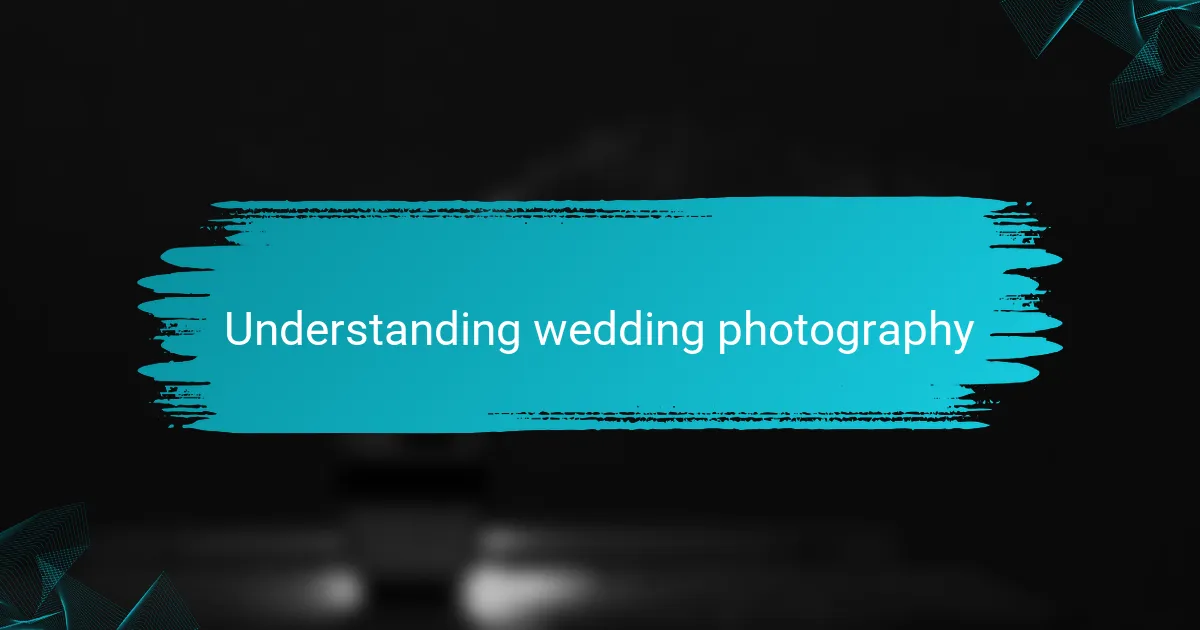
Understanding wedding photography
Wedding photography is about capturing the magic of one of the most significant days in a couple’s life. I’ve witnessed firsthand how every shot tells a unique story, blending emotion, tradition, and beauty. I remember the first Asian wedding I photographed; the vibrancy, especially from the traditional attire and decorations, created a stunning backdrop that made my heart race.
In Asian weddings, the use of direct flash can be a game changer. It enhances colors and highlights intricate details that might otherwise fade into the background, allowing me to craft images that truly reflect the joyous atmosphere. However, I’ve learned to balance this technique with softer light to preserve the warmth and intimacy of each moment.
- Captures vibrant colors and intricate details
- Creates dynamic images that reflect energy and joy
- Balances with softer light for intimacy
- Enhances traditional attire and decorations
- Helps to highlight emotional moments during the ceremony
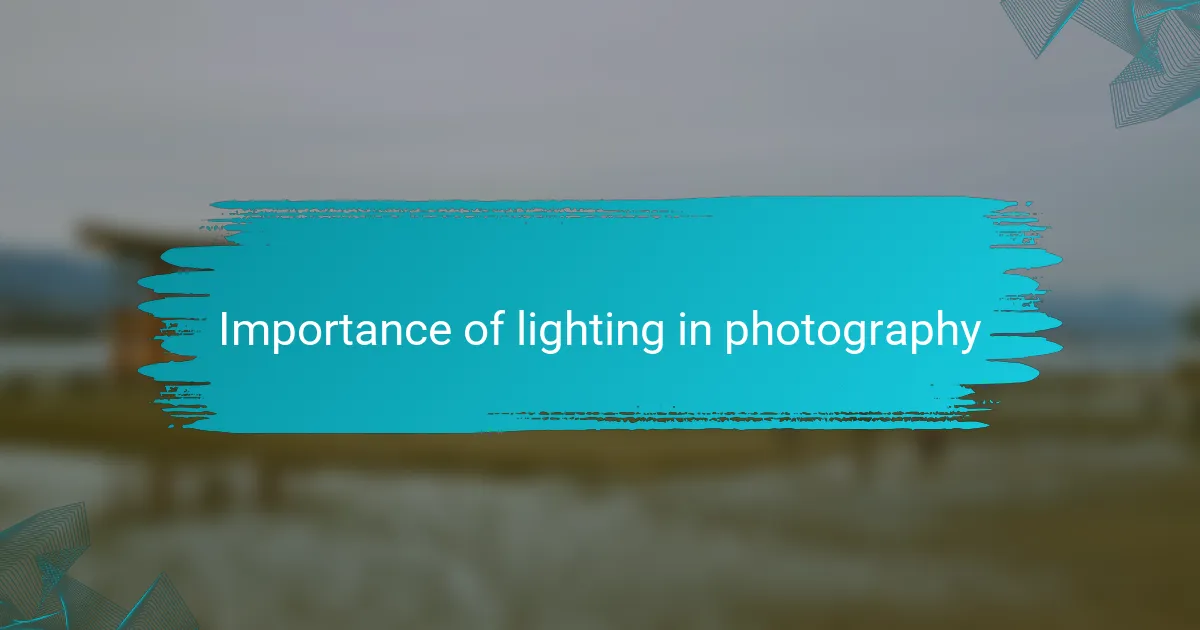
Importance of lighting in photography
Lighting is perhaps the most crucial element in photography, especially at weddings where the emotions run high and every moment is fleeting. I often find myself reflecting on how the right lighting can transform a simple scene into something breathtaking. For instance, during one wedding, a burst of direct flash illuminated the bride’s intricate henna designs, making every detail pop against her richly colored outfit. It made me wonder how often we overlook the power of light in freezing those special moments.
I’ve experienced that good lighting doesn’t just enhance colors—it creates an atmosphere. A bright, cheerful setup can mirror the couple’s joy, while softer, ambient lighting can evoke warmth and intimacy. I remember photographing a couple’s first dance under softly twinkling fairy lights, which not only highlighted their expressions but also made the entire scene feel magical and dreamy. It’s in those moments that I realize how lighting can convey emotions more profoundly than a thousand words.
Furthermore, lighting allows me to guide the viewer’s eye to what truly matters in a frame. For instance, in a bustling Asian wedding with colorful decorations, using direct flash helped draw attention to the couple while also embracing the vibrant surroundings. It’s fascinating how lighting acts as a directing force, subtly shaping the narrative of each photograph. There’s so much beauty in understanding how to manipulate it to uplift those cherished memories.

Direct flash techniques explained
Direct flash can often feel like a daunting tool in wedding photography, especially in the vibrant and dynamic setting of Asian weddings. I remember my first experience using direct flash at a wedding; the room was filled with rich colors and intricate details, but my initial shots felt harsh and uninviting. Over time, I learned to use flash creatively, softening its impact while still capturing the energy of celebrations, such as in the candid moments during a lively dance performance.
Here are some techniques that have worked wonders for me:
-
Bounce the Flash: Instead of pointing the flash directly at the subject, I often direct it toward the ceiling or a nearby wall. This diffuses the light and creates a more flattering illumination.
-
Use a Diffuser: Attaching a diffuser to my flash has transformed my images. It softens the light, reducing the harsh shadows that can occur in direct flash photography.
-
Adjust Settings: Finding the right exposure settings is crucial. I’ve found that slightly increasing my shutter speed can help balance the foreground and background lighting, making the images appear more cohesive.
-
Practice Makes Perfect: I initially struggled with timing and placement. With practice, I became adept at anticipating moments when direct flash would enhance rather than detract from the scene.
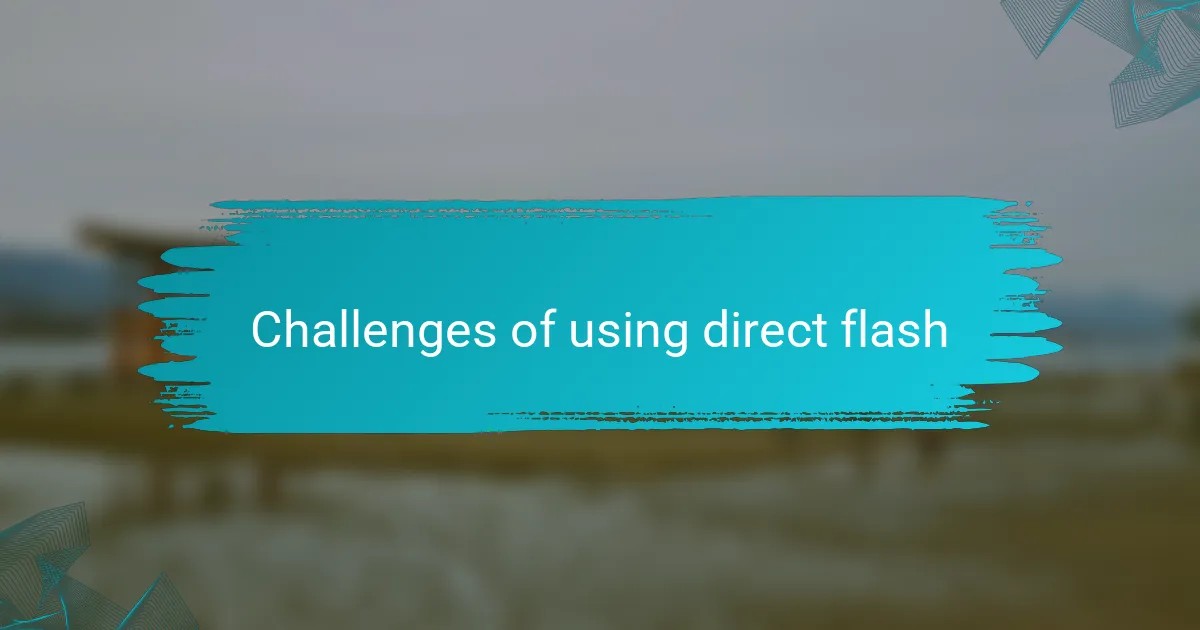
Challenges of using direct flash
Using direct flash in wedding photography, especially at Asian weddings, presents several challenges that I’ve encountered first-hand. One major issue is the harsh lighting it produces, often leading to unflattering highlights and shadows on the subjects. I remember a particular wedding where the bride’s radiant smile was overshadowed by the stark shadows cast on her face, giving an unintended harshness to the moment.
Another challenge is the reflection of direct flash off glossy surfaces like mirrors or glass, which can detract from the beauty of the setting. I recall a stunning venue filled with intricate glass decorations, and using flash highlighted unwanted glare that distracted from the overall ambiance. It certainly taught me the importance of balancing lighting with the unique features of the venue.
Lastly, the emotional response to direct flash can be a concern. I’ve noticed that the sudden burst of light can startle the guests, disrupting the natural flow of the ceremony. It’s about capturing emotions, and I strive to avoid anything that might take away from those authentic moments.
| Challenge | Impact |
|---|---|
| Harsh lighting | Can create unflattering highlights and shadows |
| Reflection issues | Distracts from the venue’s beauty |
| Emotional response | May disrupt the natural flow of the event |
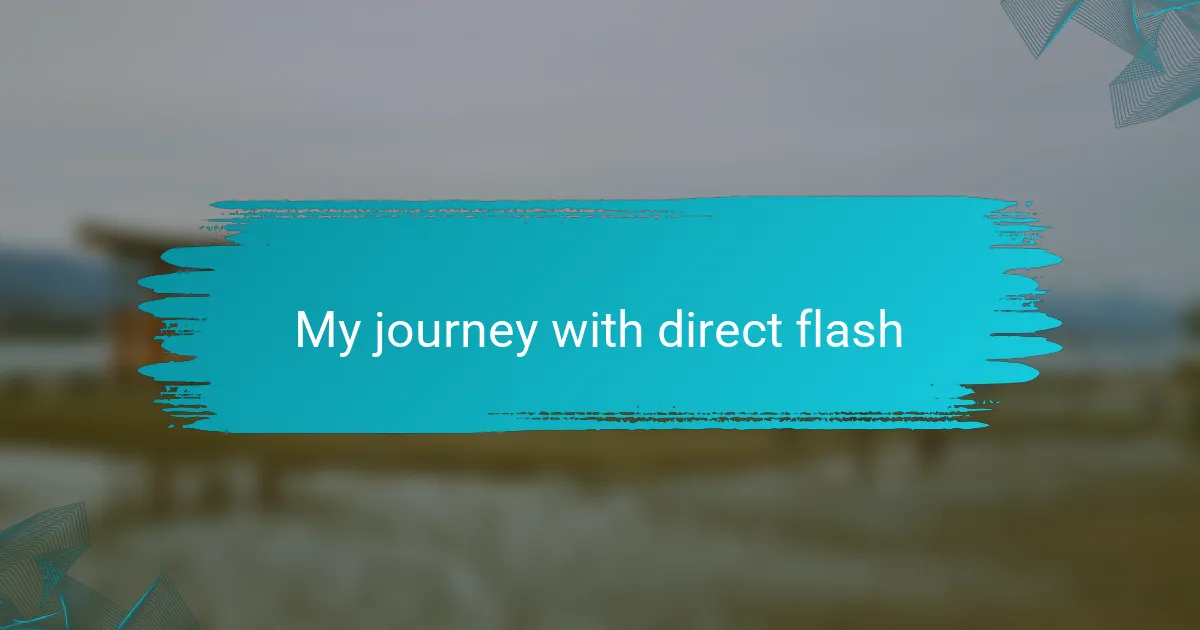
My journey with direct flash
My journey with direct flash has been quite a revelation. Initially, I was hesitant to embrace it at Asian weddings, where soft, natural lighting often reigns supreme. However, one memorable wedding taught me otherwise. As I positioned my camera to capture a vibrant dance floor, I decided to try direct flash for a few shots. The result was electrifying—bright, sharp images that showcased the joyful chaos of the celebration in a way I had never imagined.
Over time, I’ve come to appreciate direct flash for specific moments. When the bride and groom entered the ballroom with their dazzling outfits, the bold light I used added a richness to their colors. It made the intricate details of their attire pop, enhancing the overall storytelling of the day. Embracing direct flash allowed me to play with shadows, adding depth to my images and bringing life to the event.
- Direct flash brings out vibrant colors, especially in decorated venues.
- It can create unique shadow effects that add drama to the photos.
- Using it strategically helps preserve the ambiance while capturing the moment.
- Sometimes, it’s just about experimentation and finding what resonates with the event.
- I’ve found that direct flash is particularly powerful during lively dance sequences where movement is paramount.
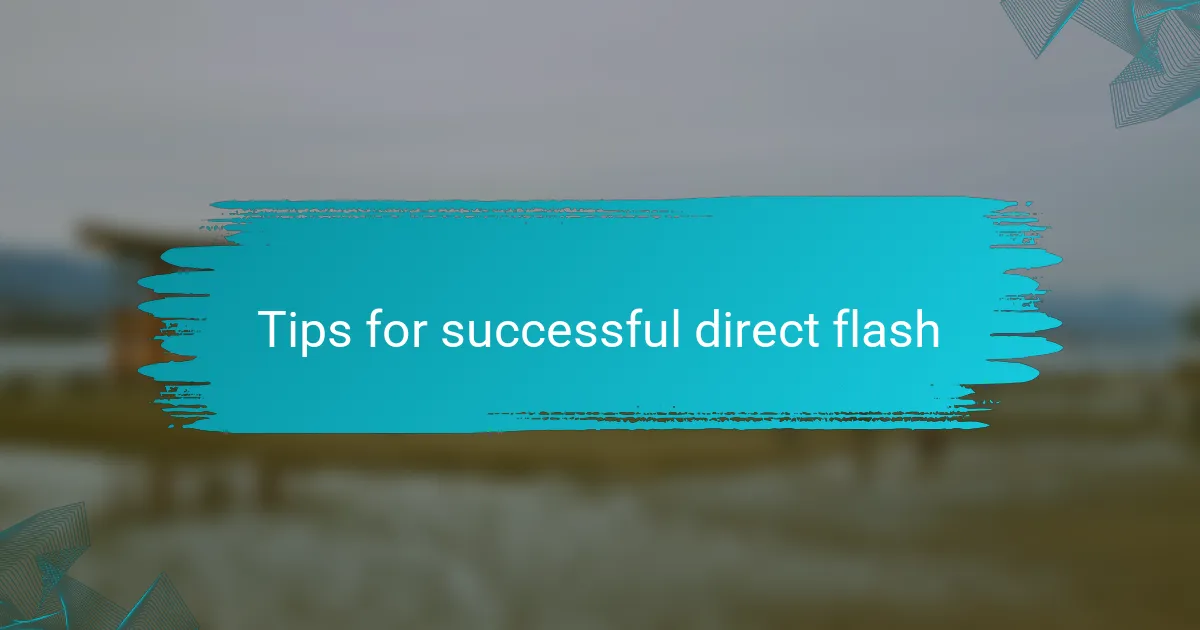
Tips for successful direct flash
When it comes to using direct flash at Asian weddings, I’ve learned a few crucial tips that can elevate your photography. First, always consider the venue’s lighting conditions. In many cases, these spaces can be dimly lit, which may tempt you to rely heavily on direct flash. However, playing with diffusion techniques, like using a softbox or bouncing the flash off nearby walls, can help soften shadows and create a more flattering light.
Another key point I find essential is to engage with your subjects. During a wedding, especially within the vibrant settings of Asian weddings, interaction can lead to more genuine expressions. I often remind myself to connect with guests and couples before snapping away; it creates a comfortable atmosphere where they are more likely to shine naturally. Lastly, don’t be afraid to adjust your flash settings. I’ve discovered that experimenting with the power can drastically change the mood of the shot.
| Tip | Description |
|---|---|
| Consider Venue Lighting | Evaluate the ambient light and adjust your flash usage accordingly. |
| Engage with Subjects | Build a connection with your subjects to capture genuine expressions. |
| Adjust Flash Settings | Experiment with different flash power to find the right balance for your shots. |
